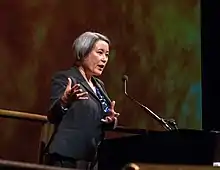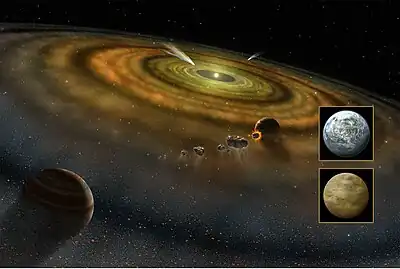Aki Roberge
Dr Aki Roberge (born c. 1973) is a research astrophysicist at NASA’s Goddard Space Flight Center, where she is currently the Associate Director for Technology and Strategy.[1] Her research focuses on observational studies of debris disks[2][3][4][5] and planet formation around nearby young stars,[6][7] with an aim to be able to characterize planets around other stars,[8] perhaps even to find signs of life on them.[9] She is particularly known for her research on the debris disk around Beta Pictoris.[10][11]
Aki Roberge | |
|---|---|
 Dr Aki Roberge lecturing at the National Air and Space Museum in 2016. | |
| Born | c. 1973 (age 49–50) Kyoto, Japan |
| Citizenship | USA |
| Alma mater | Massachusetts Institute of Technology, Johns Hopkins University |
| Known for | Debris disks, LUVOIR |
| Scientific career | |
| Institutions | Carnegie Institution for Science, NASA |
| Thesis | [ProQuest 305315892 Ultraviolet spectroscopy of circumstellar disks] (2003) |
| Doctoral advisor | Paul D. Feldman |
| Other academic advisors | Jim Elliot, Alycia J. Weinberger |
Early life and education
Born in Kyoto, Japan,[12] to an American potter[13] and a Japanese Chemical engineer,[9] Roberge grew up in a rural community in Vermont and was exposed to science in high school. She earned the bachelor's degree in Physics with a minor in Planetary science from the Massachusetts Institute of Technology in 1996 with Jim Elliot (discoverer of the rings of Uranus)[9] and the PhD in Astrophysics from Johns Hopkins University in 2002. Her thesis work, conducted under the guidance of Hopkins Professor Paul D. Feldman, was titled "Ultraviolet spectroscopy of circumstellar disks".[14] She went on to conduct postdoctoral research at the Carnegie Institution for Science with Alycia J. Weinberger before taking a position at NASA's Goddard Space Flight Center in 2005.
NASA work
Her early work at NASA continued to focus on debris disks, in particular Beta Pictoris, for which she is a recognized expert.[15] Her work was crucial in demonstrating its extreme carbon-rich nature,[11][16] and later in studying the carbon monoxide gas clouds indicating swarms of colliding comets in the young system.[17][18][19]
In 2013 she served as one of the members of the study that produced a 30-year roadmap for NASA astrophysics.[20] Her work has included substantial contributions to mission concept development, in particular being deeply involved in developing future space missions for exoplanet detection,[21] including the starshade approach to blocking starlight.[22]
LUVOIR
From 2016 to 2019 she served as the Study Scientist for the Large Ultraviolet Optical Infrared Surveyor (LUVOIR) mission concept, a multi-wavelength space telescope design developed by NASA as one of four large astrophysics space mission concepts[23] studied in preparation for the National Academy of Sciences 2020 Astronomy and Astrophysics Decadal Survey.[24][25] A primary aim of LUVOIR is to enable the investigation of a wide range of exoplanets,[26] specifically to be able to discern those that might be habitable[27] or even inhabited.[28][29] Under Roberge's leadership LUVOIR was also designed[30] with broader capabilities to build on and surpass[28] those of the Hubble Space Telescope, James Webb Space Telescope, and Nancy Grace Roman Space Telescope, enabling groundbreaking studies of the early universe, galaxy formation and evolution, star and planet formation, and Solar System bodies. This concept was compelling enough that, in 2021, a mission aligned with these goals was selected as the top priority large space mission for NASA to build across the following decades.[31]
From 2020 to 2021 Roberge was the Deputy Program Scientist for the Nancy Grace Roman Space Telescope, during which time she worked on a team to document the connection between Roman's coronagraph and LUVOIR needs.[32] Since 2022 she has been the Associate Director for Technology and Strategy in Astrophysics at Goddard.[1]

References
- "Aki Roberge's Home Page". asd.gsfc.nasa.gov. Retrieved September 1, 2022.
- "NASA Goddard's Aki Roberge Explains about Beta Pictoris". EurekAlert!. Retrieved September 1, 2022.
- "What's Cooler Than One Comet? A Storm of Them". Time. Retrieved September 1, 2022.
- "A Chaotic Planet-Forming Disk". Sky & Telescope. March 6, 2014. Retrieved September 1, 2022.
- Aki Roberge; Alycia J. Weinberger; Seth Redfield & Paul D. Feldman (June 20, 2005). "Rapid Dissipation of Primordial Gas from the AU Microscopii Debris Disk". The Astrophysical Journal. 626 (2): L105–L108. arXiv:astro-ph/0505302. Bibcode:2005ApJ...626L.105R. doi:10.1086/431899. S2CID 367734.
- "Exoplanets and the Search for Life - An Exploration in Four Lectures - Speakers from NASA & Yale University". PSW Science. Retrieved August 28, 2022.
- "Astronomers expect to find many more Earth-like planets". Financial Times. February 16, 2018. Retrieved September 1, 2022.
- "20 Big Questions about the Future of Humanity". Scientific American. 315 (3): 85–86. September 1, 2016. doi:10.1038/scientificamerican0916-28. PMID 27924887.
- "NASA Astrobiology". astrobiology.nasa.gov. Retrieved September 1, 2022.
- Roberge, A.; Feldman, P. D.; Lagrange, A. M.; Vidal-Madjar, A.; Ferlet, R.; Jolly, A.; Lemaire, J. L.; Rostas, F. (August 1, 2000). "High-Resolution HUBBLE SPACE TELESCOPE STIS Spectra of C I and CO in the β Pictoris Circumstellar Disk". The Astrophysical Journal. 538 (2): 904. arXiv:astro-ph/0003446. Bibcode:2000ApJ...538..904R. doi:10.1086/309157. S2CID 73592760.
- Roberge, Aki; Feldman, Paul D.; Weinberger, Alycia J.; Deleuil, Magali; Bouret, Jean-Claude (June 8, 2006). "Stabilization of the disk around β Pictoris by extremely carbon-rich gas". Nature. 441 (7094): 724–726. arXiv:astro-ph/0604412. Bibcode:2006Natur.441..724R. doi:10.1038/nature04832. PMID 16760971. S2CID 118990440.
- "Imagine the Universe!". imagine.gsfc.nasa.gov. Retrieved September 1, 2022.
- "Ask an Astrobiologist". astrobiology.nasa.gov. Retrieved September 2, 2022.
- Roberge, Aki (2003). Ultraviolet spectroscopy of circumstellar disks (Thesis). ProQuest 305315892.
- Billings, Lee. "Hundreds of Comets Seen Orbiting Distant Solar System". Scientific American. Retrieved September 17, 2022.
- "The Birth of Carbon Planets?". Sky & Telescope. June 9, 2006. Retrieved September 1, 2022.
- Reddy, Francis (March 7, 2014). "ALMA Reveals Unexpected Gas Clump in Debris Disc Around Beta Pictoris". SciTechDaily. Retrieved September 17, 2022.
- "ALMA sees wreckage of comet collisions in nearby solar system". ALMA Press Releases. March 6, 2014. Retrieved September 17, 2022.
- Subodh Varma (March 7, 2014). "A cosmic whodunit unfolds as ALMA investigates mysterious gas blob – Times of India". The Times of India. Retrieved September 17, 2022.
- Hall, Shannon (January 17, 2014). "Enduring Quests and Daring Visions: NASA Lays Out a Roadmap for Astrophysics". Universe Today. Retrieved September 1, 2022.
- Kaufman, Marc (March 15, 2017). "A Vision That Could Supercharge NASA". Many Worlds. Retrieved September 1, 2022.
- Wright, Chris. "To Study the Next Earth, NASA May Need to Throw Some Shade". Wired. ISSN 1059-1028. Retrieved September 1, 2022.
- "Astronomers Dream Big, Consider Four Future Space Telescopes". Sky & Telescope. November 3, 2021. Retrieved September 1, 2022.
- Foust, Jeff (January 21, 2019). "Selecting the next great space observatory". The Space Review. Retrieved September 20, 2020.
- "Decadal Survey on Astronomy and Astrophysics 2020 (Astro2020)". National Academies of Sciences, Engineering, and Medicine. March 23, 2021. Retrieved May 24, 2021.
- Bartels, Meghan (March 2, 2020). "Meet LUVOIR, which might become one of NASA's next big space telescopes". Space.com. Retrieved September 2, 2022.
- Wright, Chris. "The Gaia Mission Keeps Unlocking Secrets of the Galaxy". Wired. ISSN 1059-1028. Retrieved September 2, 2022.
- "New Space Telescopes Race For A New View Of The Cosmos". Science Friday. Retrieved September 2, 2022.
- Gasparini, Allison. "Our Sun Could Someday Reveal the Surfaces of Alien Earths". Scientific American. Retrieved September 2, 2022.
- Kaufman, Marc (March 15, 2017). "A Vision That Could Supercharge NASA". Many Worlds. Retrieved September 2, 2022.
- Witze, Alexandra (November 4, 2021). "US astronomy's 10-year plan is super-ambitious". Nature. 599 (7884): 192–193. Bibcode:2021Natur.599..192W. doi:10.1038/d41586-021-03027-y. PMID 34737412. S2CID 243761658.
- Mennesson, B.; Juanola-Parramon, R.; Nemati, B.; Ruane, G.; Bailey, V.; Bolcar, M.; Martin, S.; Zimmerman, N.; Stark, C.; Pueyo, L.; Benford, D.; Cady, E.; Crill, B.; Douglas, E.; Gaudi, B. (2020). "Paving the Way to Future Missions: the Roman Space Telescope Coronagraph Technology Demonstration". S2CID 221112127.
{{cite journal}}: Cite journal requires|journal=(help)